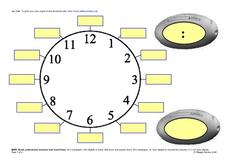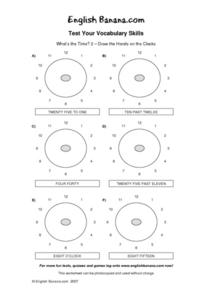Curated OER
Drawing Computed Time On A Clock
In this drawing computed time on a clock instructional activity, students explore and analyze how to set a clock's hands based on a time computation. Students either offset the time for the future (addition) or in the past (subtraction).
Curated OER
Computing Time With Two Clocks
For this computing time with two clocks worksheet, students determine and analyze time differences between two clocks. Students either choose time in the future (addition) or in the past (subtraction).
Curated OER
Computing Time With One Clock
In this computing time with one clock worksheet, students examine and practice adding and subtracting time based on what a clock shows.
Curated OER
Calendar Word Problems
In this calendar word problems worksheet, students examine, analyze and interpret how to solve a variety of word problems involving a monthly calendar.
Curated OER
Counting and Making Change
In this mathematics worksheet, students solve various counting and money problems. They identify the quarter, dime, nickel, and penny, and how much each is worth. Students also add up the totals for various combinations of the currency...
Curated OER
What's Left Over?
In this mathematics activity, students identify and find the amount remaining after subtracting different amounts from a standard currency unit. Then they select the unit of currency and identify how to present sub-dollar amounts with a...
Curated OER
Exploring Measuring
In this measuring worksheet, students explore, examine and discuss the best strategy for measuring objects. Students calculate the answers to five measuring word problems.
Curated OER
Measuring Temperature: Celsius
In this measuring temperature, Celsius, worksheet, students study, analyze and discuss how temperature tells us how hot or cold something is. Students measure the Celsius degrees of five temperatures.
Curated OER
Counting Change
In this counting change worksheet, students practice calculating the change after purchasing an item four times. Students draw the coins for the change.
Curated OER
Telephone Time
In this telephone time worksheet, students study, discuss and compare two sets of data when represented on the same graph. Students set up an original graph.
Curated OER
Reversals with Multiplication and Division
In this mathematics worksheet, students read the table that shows the answer to the cost per kilogram when 3.678 kg of a product costs $14.89 rounded to the nearest cent. They complete the table and round where necessary for each problem.
Curated OER
Multiples of Two - Money
A thorough activity for money math beginners, this learning exercise prompts students to identify, add, and multiply different coin values in several activities. Note that all coins are in British Currency, but can possibly be modified...
Curated OER
Math Practice Planning a Trip to London
In this consumer math worksheet, learners plan a weekend in London and calculate the hotel cost, shows, food and transportation. Prices are in pounds and pence. This page is suitable for UK students.
Curated OER
Easter Biscuits
In this recipe worksheet, students will rewrite a recipe for making 16 biscuits so that it will only make 12 biscuits. Then students will rewrite the recipe to make only 4 biscuits.
Curated OER
Halloween Cakes
In this recipe worksheet, students will rewrite a Halloween cakes recipe that makes 12 cakes, so that it will make 16 cakes. Ingredient amounts are in metric units.
Curated OER
Clock Faces
In this telling time worksheet, learners will build an analog clock out of paper and practice telling time. A list of teaching ideas is on page 2.
Curated OER
Test Your Vocabulary Skills: What’s the Time? 1 – Draw the Hands on the Clocks
In this telling time learning exercise, students will read the time in words and then draw the hands on an analog clock to match the words.
Curated OER
Test Your Vocabulary Skills:What’s the Time? 2 – Draw the Hands on the Clocks
In this telling time worksheet, students will read the time in words and then draw hands on a clock to match the time in words.
Curated OER
Test Your Vocabulary Skills: What’s the Time? 3 – Draw the Hands on the Clocks
In this telling time worksheet, students will read the time in words and then draw hands on a clock to match the time in words.
Curated OER
Telling Time
In this time telling activity, students discover how to tell time on a clock after discovering all the parts of a clock and the purposes of the little and big hands.
Curated OER
Percentages of Whole Numbers
In this finding percentages worksheet, students will find different percentages of whole numbers. There are a total of thirty problems.
Curated OER
Multiplication Table
In this multiplication table, students will complete the table to practice multiplication facts. The numbers across the top and down the side are 1 through 9.
Curated OER
Adding 3 Numbers
For this addition practice worksheet, 3rd graders will find the sum of 3 two-digit numbers. There are a total of 16 problems. There are pictures of bugs at the bottom.
Curated OER
Graphing a Survey
In this mathematical worksheet, students survey a selection of thirteen people to find out if they like to eat ice cream, cakes or pies and then fill in their graphs with the data they've collected.
























